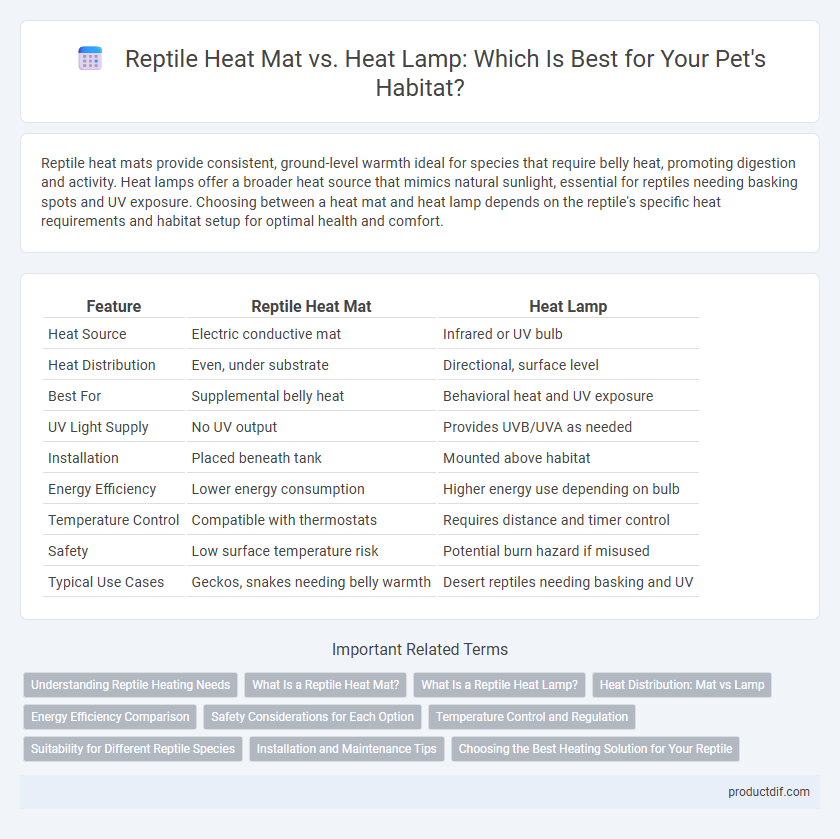Reptile heat mats provide consistent, ground-level warmth ideal for species that require belly heat, promoting digestion and activity. Heat lamps offer a broader heat source that mimics natural sunlight, essential for reptiles needing basking spots and UV exposure. Choosing between a heat mat and heat lamp depends on the reptile's specific heat requirements and habitat setup for optimal health and comfort.
Table of Comparison
| Feature | Reptile Heat Mat | Heat Lamp |
|---|---|---|
| Heat Source | Electric conductive mat | Infrared or UV bulb |
| Heat Distribution | Even, under substrate | Directional, surface level |
| Best For | Supplemental belly heat | Behavioral heat and UV exposure |
| UV Light Supply | No UV output | Provides UVB/UVA as needed |
| Installation | Placed beneath tank | Mounted above habitat |
| Energy Efficiency | Lower energy consumption | Higher energy use depending on bulb |
| Temperature Control | Compatible with thermostats | Requires distance and timer control |
| Safety | Low surface temperature risk | Potential burn hazard if misused |
| Typical Use Cases | Geckos, snakes needing belly warmth | Desert reptiles needing basking and UV |
Understanding Reptile Heating Needs
Reptile heat mats provide consistent, ground-level warmth ideal for species that absorb heat from their environment, promoting natural thermoregulation. Heat lamps emit radiant heat that simulates sunlight and support basking behavior, essential for reptiles requiring UVB exposure and higher temperature gradients. Selecting between a heat mat and heat lamp depends on the reptile's species, habitat preferences, and specific thermal requirements to optimize health and behavior.
What Is a Reptile Heat Mat?
A reptile heat mat is a thin, flexible heating pad designed to provide consistent, low-level warmth by being placed underneath a terrarium or substrate, essential for regulating a reptile's body temperature. It uses electric resistance to emit gentle heat from below, mimicking the natural environment where reptiles absorb heat from warm surfaces. Heat mats are energy-efficient and ideal for maintaining a stable basking area without overwhelming reptiles with excessive light or heat.
What Is a Reptile Heat Lamp?
A reptile heat lamp is an essential heating device designed to provide controlled radiant heat that replicates the warmth of the sun for reptiles. These lamps emit infrared or UVB light, promoting thermoregulation, metabolism, and overall health in reptiles like bearded dragons, geckos, and snakes. Unlike heat mats, heat lamps offer adjustable temperature zones and improve basking behavior, crucial for species requiring direct heat exposure.
Heat Distribution: Mat vs Lamp
Reptile heat mats provide consistent, even heat distribution across the substrate, ideal for creating a warm basking area without hotspots. Heat lamps deliver intense, focused warmth that mimics natural sunlight but can create uneven temperatures with hotter zones directly beneath the lamp and cooler areas further away. Choosing between a heat mat and heat lamp depends on the specific heat gradient needs of your reptile species and enclosure setup.
Energy Efficiency Comparison
Reptile heat mats typically consume 10 to 30 watts for consistent ground warmth, making them more energy-efficient compared to heat lamps that often range between 50 to 100 watts to provide ambient heat. Heat mats deliver direct, localized heat ideal for maintaining stable substrate temperature with minimal energy use, while heat lamps emit broader, less focused warmth necessitating higher power consumption. Choosing a heat mat over a heat lamp can reduce electricity costs and lower environmental impact in reptile habitat heating.
Safety Considerations for Each Option
Reptile heat mats offer consistent, low-intensity warmth directly beneath enclosures, reducing the risk of burns when paired with thermostats for temperature regulation. Heat lamps provide higher radiant heat but require careful placement and protective guards to prevent overheating and direct skin contact injuries. Both heating options demand routine monitoring to ensure stable temperatures and prevent hazards like dehydration or thermal shock in reptiles.
Temperature Control and Regulation
Reptile heat mats provide consistent under-tank warmth with precise temperature control through adjustable thermostats, ideal for maintaining stable basking zones. Heat lamps offer variable heat intensity and can simulate natural light cycles, but often require careful monitoring to prevent overheating and ensure proper temperature gradients. Both heat sources are essential for reptile thermoregulation, but heat mats offer safer, more energy-efficient temperature regulation for nocturnal or burrowing species.
Suitability for Different Reptile Species
Reptile heat mats provide consistent, low-level warmth ideal for ground-dwelling species such as leopard geckos and corn snakes, promoting natural burrowing behavior without overheating. Heat lamps offer radiant heat and UVB light, essential for arboreal reptiles like bearded dragons and chameleons that require basking spots and vitamin D3 synthesis. Selecting the appropriate heating method depends on the reptile's habitat preferences, activity level, and thermoregulation needs to ensure optimal health and comfort.
Installation and Maintenance Tips
Reptile heat mats offer easy installation by simply placing them under the enclosure's substrate, requiring minimal wiring and no overhead mounting, which reduces the risk of burns or overheating. Heat lamps demand secure mounting above the habitat to ensure even heat distribution while necessitating frequent bulb replacements and monitoring to prevent fire hazards. Regularly clean heat mats to remove dust and inspect cords for damage, while heat lamps need routine checks for bulb lifespan and fixture stability to maintain safe and efficient operation.
Choosing the Best Heating Solution for Your Reptile
Reptile heat mats provide consistent, localized warmth ideal for burrowing species, while heat lamps offer broader heat distribution and naturalistic basking spots favored by arboreal reptiles. Optimal heating depends on your reptile's habitat needs, thermoregulation behavior, and size, with mats excelling in substrate heating and lamps supporting overall enclosure temperature gradients. Selecting the best solution involves balancing temperature control precision, safety, and energy efficiency tailored to your reptile's specific species requirements.
Reptile Heat Mat vs Heat Lamp Infographic

 productdif.com
productdif.com